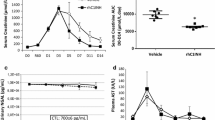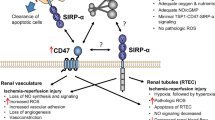Abstract
Objective and design
The pathophysiology of ischemia/reperfusion (I/R) injury is dominated by an inflammatory response. In the identification of new therapeutic agents, the role of individual cytokines may be essential. Interleukin (IL)-9 is a pleiotropic cytokine recently identified to be involved in various immune responses. In this study, the role of IL-9 in renal I/R injury was assessed.
Methods
We performed repeated direct measurements of arteriovenous IL-9 concentration differences over the reperfused graft in human kidney transplantation.
Results
Substantial renal IL-9 release was observed from deceased donor kidneys (P = 0.006). In contrast, living donor kidneys, which have a more favourable clinical outcome, did not release IL-9 during early reperfusion (P = 0.78). Tissue expression of IL-9 did not change upon reperfusion in both living and deceased human donor kidneys. To assess the role of IL-9 in I/R injury, an experimental study comprising IL-9 inhibition in mice undergoing renal I/R was performed. Although there was no difference in kidney function, structural damage was significantly aggravated in anti-IL-9 treated mice.
Conclusions
Deceased donor grafts show a substantial IL-9 release upon reperfusion in clinical kidney transplantation. However, inhibition of IL-9 aggravated kidney damage, suggesting a regulating or minor role of IL-9 in clinical I/R injury.





Similar content being viewed by others
References
Koning OH, Ploeg RJ, van Bockel JH, Groenewegen M, van der Woude FJ, Persijn GG, European Multicenter Study Group, et al. Risk factors for delayed graft function in cadaveric kidney transplantation: a prospective study of renal function and graft survival after preservation with University of Wisconsin solution in multi-organ donors. Transplantation. 1997;63:1620–8.
Ojo AO, Wolfe RA, Held PJ, Port FK, Schmouder RL. Delayed graft function: risk factors and implications for renal allograft survival. Transplantation. 1997;63:968–74.
Yarlagadda SG, Coca SG, Formica RN Jr, Poggio ED, Parikh CR. Association between delayed graft function and allograft and patient survival: a systematic review and meta-analysis. Nephrol Dial Transplant. 2009;24:1039–47.
Burne MJ, Elghandour A, Haq M, Saba SR, Norman J, Condon T, et al. IL-1 and TNF independent pathways mediate ICAM-1/VCAM-1 up-regulation in ischemia reperfusion injury. J Leukoc Biol. 2001;70(2):192–8.
Patel NS, Chatterjee PK, Di Paola R, Mazzon E, Britti D, De Sarro A, et al. Endogenous interleukin-6 enhances the renal injury, dysfunction, and inflammation caused by ischemia/reperfusion. J Pharmacol Exp Ther. 2005;312:1170–8.
Jo SK, Sung SA, Cho WY, Go KJ, Kim HK. Macrophages contribute to the initiation of ischaemic acute renal failure in rats. Nephrol Dial Transplant. 2006;21:1231–9.
Nijboer WN, Schuurs TA, van der Hoeven JA, Leuvenink HG, van der Heide JJ, van Goor H, et al. Effects of brain death on stress and inflammatory response in the human donor kidney. Transplant Proc. 2005;37:367–9.
Stangl M, Zerkaulen T, Theodorakis J, Illner W, Schneeberger H, Land W, et al. Influence of brain death on cytokine release in organ donors and renal transplants. Transplant Proc. 2001;33:1284–5.
Jassem W, Koo DD, Muiesan P, Cerundolo L, Rela M, Fuggle SV, et al. Non-heart-beating versus cadaveric and living-donor livers: differences in inflammatory markers before transplantation. Transplantation. 2003;75:1386–90.
de Vries DK, Lindeman JH, Ringers J, Reinders ME, Rabelink TJ, Schaapherder AF. Donor brain death predisposes human kidney grafts to a proinflammatory reaction after transplantation. Am J Transplant. 2011;11:1064–70.
Soussi-Gounni A, Kontolemos M, Hamid Q. Role of IL-9 in the pathophysiology of allergic diseases. J Allergy Clin Immunol. 2001;107:575–82.
Noelle RJ, Nowak EC. Cellular sources and immune functions of interleukin-9. Nat Rev Immunol. 2010;10:683–7.
Gessner A, Blum H, Rollinghoff M. Differential regulation of IL-9-expression after infection with Leishmania major in susceptible and resistant mice. Immunobiology. 1993;189:419–35.
Lu LF, Lind EF, Gondek DC, Bennett KA, Gleeson MW, Pino-Lagos K, et al. Mast cells are essential intermediaries in regulatory T-cell tolerance. Nature. 2006;442:997–1002.
Stassen M, Arnold M, Hultner L, Muller C, Neudorfl C, Reineke T, et al. Murine bone marrow-derived mast cells as potent producers of IL-9: costimulatory function of IL-10 and kit ligand in the presence of IL-1. J Immunol. 2000;164:5549–55.
de Vries DK, Lindeman JH, Tsikas D, de Heer E, Roos A, de Fijter JW, et al. Early renal ischemia-reperfusion injury in humans is dominated by IL-6 release from the allograft. Am J Transplant. 2009;9:1574–84.
Haslinger B, Kleemann R, Toet KH, Kooistra T. Simvastatin suppresses tissue factor expression and increases fibrinolytic activity in tumor necrosis factor-alpha-activated human peritoneal mesothelial cells. Kidney Int. 2003;63:2065–74.
Kleemann R, Verschuren L, van Erk MJ, Nikolsky Y, Cnubben NH, Verheij ER, et al. Atherosclerosis and liver inflammation induced by increased dietary cholesterol intake: a combined transcriptomics and metabolomics analysis. Genome Biol. 2007;8:200–15.
Jones TG, Hallgren J, Humbles A, Burwell T, Finkelman FD, Alcaide P, et al. Antigen-induced increases in pulmonary mast cell progenitor numbers depend on IL-9 and CD1d-restricted NKT cells. J Immunol. 2009;183:5251–60.
Eller K, Wolf D, Huber JM, Metz M, Mayer G, McKenzie AN, et al. IL-9 production by regulatory T cells recruits mast cells that are essential for regulatory T cell-induced immune suppression. J Immunol. 2011;186:83–91.
Lu L, Leemhuis T, Srour EF, Yang YC. Human interleukin (IL)-9 specifically stimulates proliferation of CD34 +++DR+ CD33- erythroid progenitors in normal human bone marrow in the absence of serum. Exp Hematol. 1992;20:418–24.
Donahue RE, Yang YC, Clark SC. Human P40 T-cell growth factor (interleukin-9) supports erythroid colony formation. Blood. 1990;75:2271–5.
Fontaine RH, Cases O, Lelievre V, Mesples B, Renauld JC, Loron G, et al. IL-9/IL-9 receptor signaling selectively protects cortical neurons against developmental apoptosis. Cell Death Differ. 2008;15:1542–52.
Poulin LF, Richard M, Le Moine A, Kiss R, McKenzie AN, Goldman M, et al. Interleukin-9 promotes eosinophilic rejection of mouse heart allografts. Transplantation. 2003;76:572–7.
Li XC, Schachter AD, Zand MS, Li Y, Zheng XX, Harmon WE, et al. Differential expression of T-cell growth factors in rejecting murine islet and human renal allografts: conspicuous absence of interleukin (IL)-9 despite expression of IL-2, IL-4, IL-7, and IL-15. Transplantation. 1998;66:265–8.
Acknowledgments
This work was financially supported by The Netherlands Organization for Health Research and Development (Project 92003525 to D.V.).
Author information
Authors and Affiliations
Corresponding author
Additional information
Responsible Editor: Artur Bauhofer.
K. A. Kortekaas and D. K. de Vries contributed equally to this article.
Electronic supplementary material
Below is the link to the electronic supplementary material.
Rights and permissions
About this article
Cite this article
Kortekaas, K.A., de Vries, D.K., Reinders, M.E.J. et al. Interleukin-9 release from human kidney grafts and its potential protective role in renal ischemia/reperfusion injury. Inflamm. Res. 62, 53–59 (2013). https://doi.org/10.1007/s00011-012-0550-7
Received:
Accepted:
Published:
Issue Date:
DOI: https://doi.org/10.1007/s00011-012-0550-7




